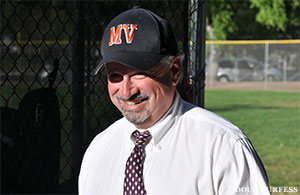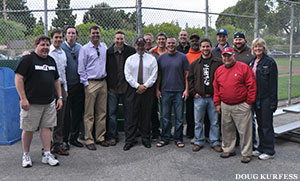After 30 years as Joe Mitchner's friend, there are two things I can attest to: He doesn't smile or get surprised easily.

Getting those two reactions simultaneously on a recent evening was decades in the making. As he walked to the Little League field at McKelvey Park in Mountain View, Calif., he gave me the usual nod. It's that bromantic look that refuses to give in to emotion, even when your friend has traveled all the way from Florida just to see you coach one of your final Little League games. Way back in the late 1980s and early 1990s, I spent eight years coaching with Mitchner, getting to know his idiosyncracies far too well.
So when I said to Mitchner, "Say hi to Doug Kurfess," that's when my long-time friend got caught off guard. When I pointed to John Gilmore, then Tim Wagstaffe and his mother, Sue, and fellow former team parents Sam and Kathy Felix, and to the host of other former players and parents who showed up that night, that's when the smile and the surprise overtook Mitchner’s usual poker face.
For 36 years, or since he was barely older than the kids he coaches today, Mitchner has volunteered his time to Little League baseball, not to mention other sports. At 50, Mitchner is retiring from Little League. Sometime this weekend or perhaps in the next few weeks -- should Mitchner coach the Mountain View All-Star team -- he will walk away from the compacted diamond for the last time.
I'm sure 36 years is not a Little League record, even if anyone kept track. That's not the point. Plenty of men and women have given their time to Little League or Boy Scouts or to any number of volunteer youth organizations. This is not a comparison or a commemoration. Mitchner isn't somehow better than men like Tom Sutter or George Blondino or Jack Mathews or any of the thousands of others who have given their time to Little League. But he is in their league and that's testament enough.
Mitchner isn't sick, and he's not down. He's just done. Some 800 games, even more practices and enough bunt signs to resemble a tick are enough. Seven trips to Arizona with his teams for spring training and bonding were icing on the cake. He has given more than his fair share. You could sell very secure municipal bonds on what he has paid forward between his years in the Mountain View and Alpine Little Leagues, not to mention two years coaching 14- and 15-year-olds while attending business school at UCLA.
Mitchner worked at Oracle and counted beans for the Stanford Athletic Department once upon a time, but his real accomplishment has been spending more than 3 1/2; decades building memories. He has done that mostly for others, men who earlier this month were able to feel like boys again, if only for a couple of hours.
There was Kirk Phelps, asking if I remembered the time he got tossed out of a game for lowering his shoulder and plowing into a third basemen trying to make a tag. Phelps might have been the smartest player Joe and I ever coached, but we failed to teach him that Little League is supposed to be a non-contact activity. There was Tom Brown, remembering the time he struck out Eric Byrnes on three pitches. Yes, that would be former major leaguer Eric Byrnes, who played for the dreaded Morey's but managed to survive it and become a good human being. It happened Byrnes, don’t deny it.
There was Kurfess, who along with Clancy Hoban inspired me to arrange this reunion, talking about his knuckleball. There was Wagstaffe, now a district attorney in Alameda County but still armed with the warm, inviting grin that prompted me to describe him as "the kid who is probably the nicest guy in school" when he was 11. My point was that Wagstaffe, who was practicing on the mound at the time, needed to get a little nastier.
"Some people in the office say that about me today," Wagstaffe said, a little sheepishly.

There was Al Courtney and his son Mike, walking in together as always and still looking like the picturesque vision of a father and son. There was Josh Russell, now a father himself, but still very much the shy-yet-talented kid he was at 12. There was Adam Culp, who showed off his toughness again by driving all the way from Denver for the event. At 12, Culp played catcher and third base, once barehanding a throw from across the diamond at third and not even flinching.
There was Gilmore and his eager, happy grin, ready to do whatever was asked and being really good at just about everything. There was Joe Kavanaugh, still a strapping athlete who played tight end in college. There was Ariel Jakobovits, just as brilliant as Phelps and armed with a fastball that took the Alpine All-Star team all the way to the NorCal Regionals.
So many others wished they had been there, such as John Heinz. The son of former NFL player Bob Heinz, John was 6-feet tall at 12. He was left-handed, burly, a great fielder and an intimidating pitcher. Foot speed wasn't one of his attributes. But when Mitchner counted stats, advancing on a passed ball or wild pitch was considered a stolden base (Hey, it's Little League; you can be generous with certain stats).
Among Mitchner's many traditions was the game ball he gave out after every victory, writing the date, score and key stats on the ball for the player who earned it. Almost 20 years later, Heinz and Kurfess battle their wives to keep their game balls from being tossed each spring cleaning.
"My wife just didn't see the irony of a 2-0 Anderson (Chevrolet) win where I had 2 hits, somehow 'stole' 6 bags and scored both runs. See, no one would believe that game line, but since I have a game ball to prove it," Heinz wrote in an e-mail lamenting his absence.
Mitchner has 30-something years of statistics compiled from every kid who ever played on one of his Major Division teams and all the scorebooks to prove the numbers. He counted pitches before Little League made it a national rule, dissecting all sorts of numbers. He collected so many stats that by the end of the season, when we held the team party and had each kid sit in the Chair of Honor to review his season, there were plenty of stats to make everybody look like a star.
That doesn't mean it was all idyllic. Coaching is not about quoting stats and sitting around telling stories. As the fictional Jimmy Dugan once put it: "It's supposed to be hard. If it wasn't hard, everyone would do it. The hard ... is what makes it great."
For instance, teaching kids to hustle was tricky. Mitchner came up with one of my favorite teaching tools, the "in-and-out" drill, which we used roughly once every two years during my eight years as his assistant (before either of us had kids ourselves). The rule on a Mitchner team (be it Derry’s Feed & Fuel, Anderson Chevrolet or the current Larry’s Auto Works Giants) is that every player has to run in from the field after the third out and run back to his position when a new inning begins. It was about basic hustle, energy and enthusiasm.
About every two years, once a couple of age groups of players had moved on, the kids would start to forget the basic rule. After a couple of gentle reminders, it was time for the in-and-out drill -- a full two-hour practice of running from your position to the dugout and back out to your position. The trick was that the "dugout" would change location, starting off in the normal spot on the field and progressively moving during the practice until is was a couple of hundred yards away. For the next year or so, the mere mention of the "in-and-out" drill would create desperate sprints.

Other drills we implemented also might not work today. We'd "interview" each kid to find out if they had younger brothers or sisters who might be good in baseball (brother options are key in Little League). During tryouts, we’d take Polaroids of each kid standing next to one or the other of us to remember how tall they were. We'd then go to a local bar to arrange the photos in order of how good the players were so we were ready for the draft.
We might get arrested for that now.
From there, there were all sorts of drills, from first-and-third situations to bunt coverage to every imaginable steal scenario. There was BP and grounders, bunts and even the “Home Run Derby,” a just-for-fun practice where kids would hit Wiffle Balls over a fence a short distance away. Yeah, there was occasional yelling and not every kid came away loving Little League. But there’s a difference between demanding and denigrating, and Mitchner has always known that line.
As we stood there catching up, telling stories, laughing and hugging, the bonds etched from so many hours together so long ago were still strong. Mitchner may not have been the central figure of every story, but he was at the center of creating them. He’s the one who taught the players the delayed steal that I later called for Phelps to execute as a 10-year-old. Phelps took home without even a throw in what was one of my favorite moments as a coach because the execution was so perfect.
There are so many other moments to remember. Jess Warrington, the only player tougher than Culp and another guy who sadly couldn’t make the reunion, rattled off a series of memories in an e-mail. There was everything from playing catcher as a 10-year-old with a 12-year-old Kavanaugh throwing gas -- "taking 32-foot fastballs off the cup from Kavanaugh … seemed like he was throwing 100 mph at age 12" -- to having to deal with famed umpire “Low Ball” Barton’s worm-killing strike zone, to enjoying the elegant cuisine of Little League (nachos in a Styrofoam bowl) on a cold night at Ford Field in Portola Valley.
In summary, Warrington wrote: "Anderson Chevrolet ... Alpine Little League ... nothing better. Great memories."
To Joe Mitchner, thanks for letting me be part of it.




